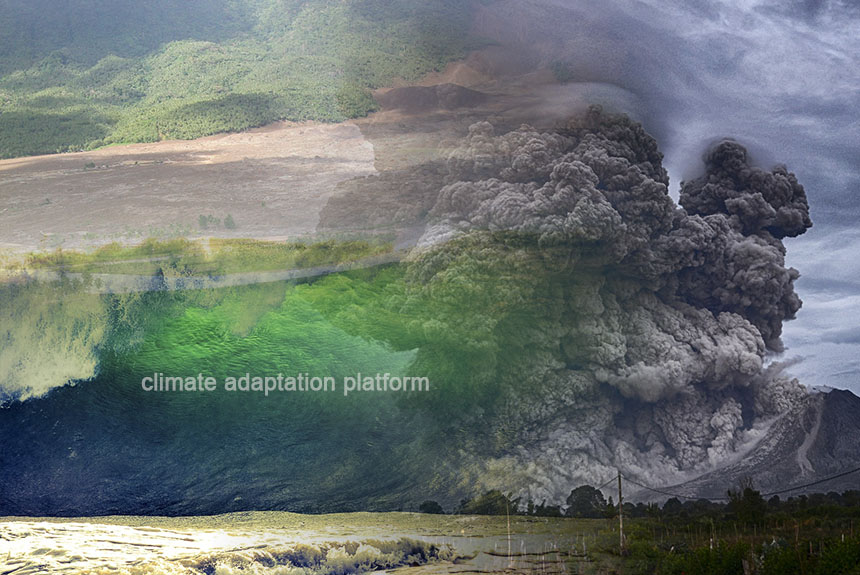Indonesia is no stranger to natural disasters. Its location on the Pacific Ring of Fire and at the intersection of three major tectonic plates make it particularly prone to volcanic eruptions, earthquakes, and tsunamis.
It also experiences an annual monsoon season, which causes yearly flooding and landslides. Hazard maps show that around 5%—more than 11 million people—live in areas prone to earthquakes, and around 2.5 million people are exposed to tsunamis.
As the world’s largest archipelagic nation, 70% of its population lives in coastal areas, and a sizeable coastal population lives in low-lying areas, making them particularly vulnerable to the impacts of flooding and rising sea levels.
Indonesia also ranks in the top third of countries in the world most at risk of climate hazards, including heat waves, flooding, and droughts.
Establishing disaster risk finance in Indonesia
In response to the country’s high vulnerability to natural hazards and climate change effects, the government launched a national disaster risk finance strategy in 2018 with the support of the Swiss State Secretariat (SECO) and technical assistance from the World Bank. When disaster hits, having ready access to finance for response, recovery, and reconstruction activities can bolster the country’s resilience.
According to the World Bank, too often, funding for such events is considered “tomorrow’s” problem. Still, when it comes to this, governments are forced to reallocate funds from existing budgeted development programs or wait for humanitarian and development partners to rescue them. DRF is a way to think about tomorrow’s problems “today”.
Since the DRF was launched in 2018, significant developments have occurred, such as establishing the Pooling Fund for Disasters (Pooling Fund Bencana, PFB) and the state asset insurance program (ABMN). The PFB is envisioned to be the central state budget protection mechanism, and the ABMN is already offering insurance coverage to over 7,000 public buildings with over US$2bn in sum insured. These programs have been implemented with financial and technical support from the World Bank and two other international organisations.
Building the capacity of Indonesia’s government to implement its DRF program
Requests from the government to requests from the Indonesian government for more capacity building to implement its DRF strategy have led the World Bank team to design the first-ever nationally curated DRF Executive Education Program in partnership with a local university, the Institut Teknologi Bandung (ITB).
In November 2023, the ITB-World Bank DRF Education Program pilot was delivered to select government officials working on the DRF to test the content on them and make subsequent adjustments to the content to fit the government’s needs.
Between October 30 and November 3, 2023, the World Bank’s Finance, Competitiveness, and Innovation (FCI) team organised a knowledge exchange trip for Indonesian government officials to Switzerland to enhance their comprehension of the Swiss Disaster Risk Finance (DRF) and Disaster Risk Management (DRM) systems.
The objective was to facilitate technical knowledge exchange to help the Government of Indonesia implement its Pooling Fund for Disasters (Pooling Fund Bencana, PFB) and the state asset insurance (ABMN) program.
DRF is an approach to financial planning in which countries can prearrange finance before climate shocks and disasters. This allows ready access to financing for response, recovery, and reconstruction activities when such events occur.
Indonesia’s successful establishment of a DRF and its effort to continually enhance its capacity to implement the program successfully by partnering with international organisations can help bolster the country’s resilience to natural hazards and the effects of climate change. Countries facing similar vulnerabilities and risks can learn from Indonesia’s example.
Source:
Zen, F. (2023, September 26). Strategies for strengthening disaster finance in Indonesia. Observer Research Foundation. Retrieved from https://www.orfonline.org/expert-speak/strategies-for-strengthening-disaster-finance-in-indonesia
Indonesia – Disaster Risk Finance and Insurance Project. (2020). Indonesia – Disaster Risk Finance and Insurance Project. The World Bank. Retrieved from https://documents.worldbank.org/en/publication/documents-reports/documentdetail/316601611543685552/indonesia-disaster-risk-finance-and-insurance-project
Indonesia’s Pooling Fund Bencana: Knowledge Exchange Visit on Disaster Risk Financing and Insurance (DRFI) in Switzerland. (2024 January). Financial Protection Forum. Retrieved from https://www.financialprotectionforum.org/publication/indonesia%E2%80%99s-pooling-fund-bencana-knowledge-exchange-visit-on-disaster-risk-financing-and
Pratami, D. (2023, August 24). Riding the waves for a blue future in Indonesia
. United Nations Sustainable Development Group. Retrieved from: https://unsdg.un.org/latest/blog/riding-waves-blue-future-indonesia



Leave a Reply